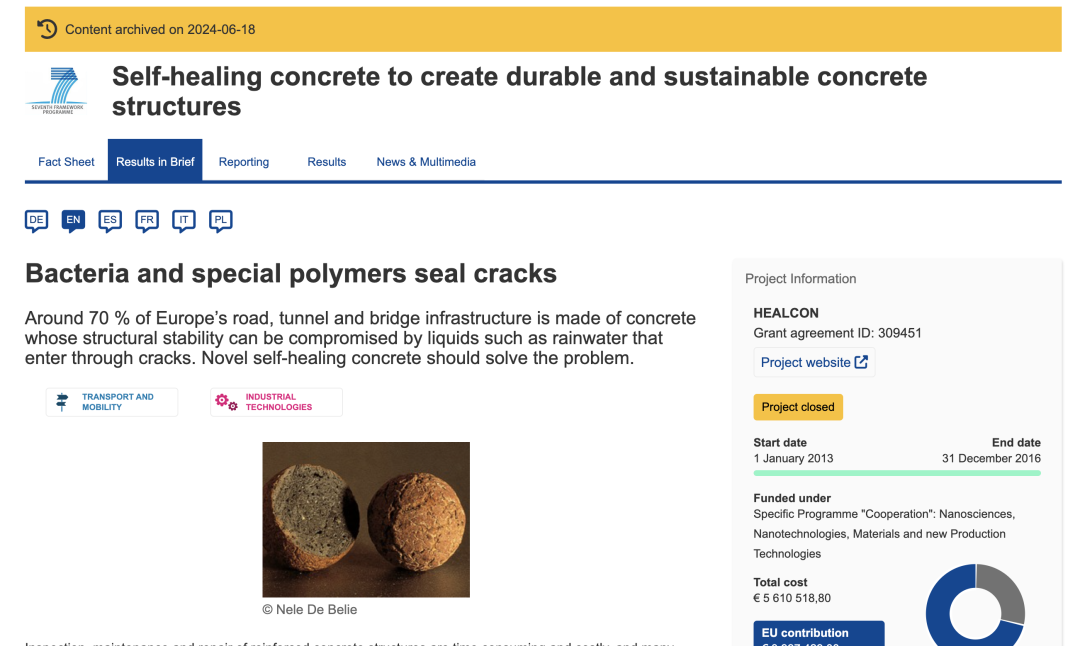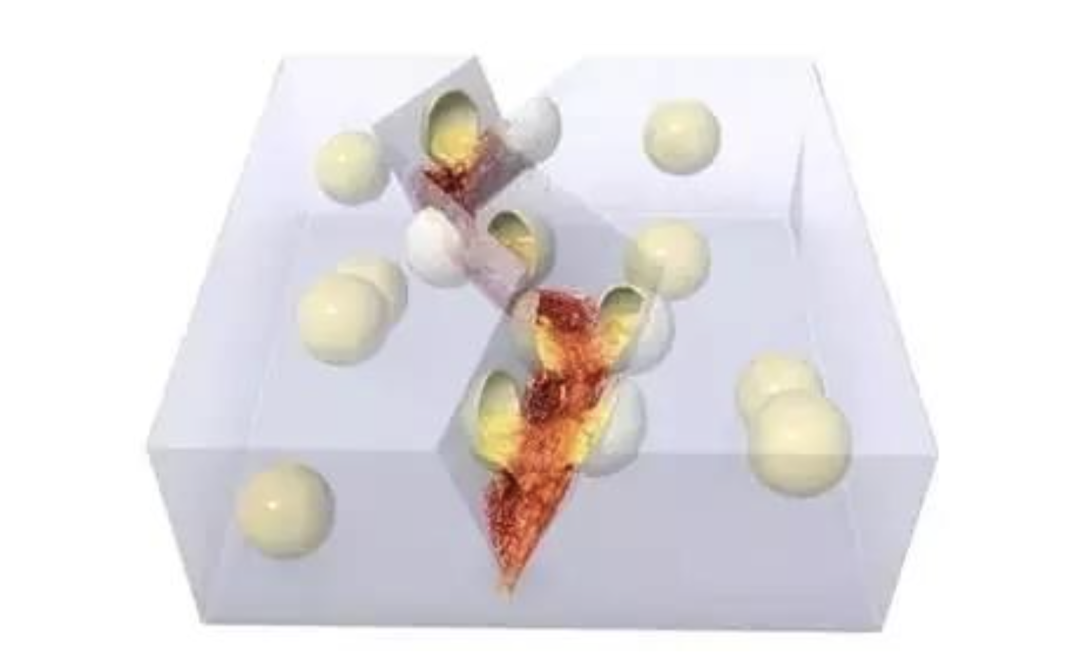As we traverse the steel and concrete of our cities daily, the roads beneath our feet, the bridges above our heads, and the houses we live in—these infrastructures that support modern life are quietly undergoing the erosion of time. Globally, aging infrastructure resembles a “silent crisis,” and the traditional passive maintenance model (Identify Issues → Assess and Plan → Repair → Acceptance) not only causes maintenance costs to snowball but also inadvertently buries safety hazards.In this context, self-healing infrastructure driven by smart materials, artificial intelligence (AI), and sensor networks is emerging as a transformative approach to autonomously maintain structural integrity.It injects a “self-healing gene” into infrastructure, reshaping the future of urban lifelines.1. Global Case Studies
The HEALCON project in Europe applied bacterial concrete in tunnels, successfully achieving closure of 0.8 mm cracks and extending structural lifespan by 30%;
Case Study: HEALCON (Self-healing concrete to create durable and sustainable concrete structures) is a research project funded by the EU’s Seventh Framework Programme (FP7), aimed at developing concrete structures with self-healing capabilities to enhance durability and sustainability.

The research focus of this project includes:
-
Utilizing bacteria (such as Bacillus) that can precipitate calcium carbonate to fill cracks, enhancing the water tightness of concrete.
-
Developing smart hydrogel materials that can absorb water and expand at the crack site, preventing further moisture penetration.
-
Researching encapsulated polymers like polyurethane to address bending cracks caused by dynamic loads.
Experimental results indicate that these self-healing technologies can effectively seal early cracks, extend the lifespan of concrete structures, and reduce maintenance costs.
The Netherlands’ smart highway explores induction heating and steel fiber self-healing asphalt, providing new ideas for road maintenance;
Case Study: In the smart highway project in the Netherlands, the technology of self-healing asphalt using induction heating and steel fibers was explored.
The key points of this technology include:
-
Adding fine steel wool fibers to the asphalt mixture to make it conductive.
-
Heating the steel fibers with induction heating equipment, which in turn heats the surrounding asphalt, allowing it to flow and fill micro-cracks, thus achieving self-repair.
On the A58 highway in the Netherlands, researchers laid a 400-meter-long test section and conducted long-term monitoring.
Research found that this technology can significantly extend the lifespan of roads, reducing maintenance frequency and costs.
Additionally, induction heating technology has environmental advantages, reducing resource consumption and traffic disruption during road maintenance.
The following is a technical vision:
1. Self-healing Infrastructure: The “Smart New Species” in the Infrastructure Field
Self-healing infrastructure is an innovative existence that breaks the traditional maintenance model of infrastructure.
 It breaks the passive cycle of traditional structures: “Damage – Detection – Repair.” It can autonomously complete the detection, diagnosis, and repair of structural damage like a living organism. Through the collaborative operation of smart materials, sensor networks, and AI algorithms, it forms a complete autonomous maintenance system, effectively avoiding catastrophic failures, extending facility lifespan, and significantly reducing maintenance costs.
It breaks the passive cycle of traditional structures: “Damage – Detection – Repair.” It can autonomously complete the detection, diagnosis, and repair of structural damage like a living organism. Through the collaborative operation of smart materials, sensor networks, and AI algorithms, it forms a complete autonomous maintenance system, effectively avoiding catastrophic failures, extending facility lifespan, and significantly reducing maintenance costs.
2. Core Components
(1) Smart Materials: Engineering substances with “repair skills”
Smart materials are key to self-healing infrastructure. Microcapsule repair agents act like “first aid kits” embedded in the material; when a crack occurs, the capsules burst, releasing polymers or adhesives to quickly fill the gap; shape memory alloys act like metals with “memory magic,” restoring their original shape when heated, combating stress deformation in bridges and tunnels; bacterial concrete utilizes the marvelous combination of Bacillus and calcium lactate to produce limestone when wet, naturally sealing cracks.
(2) Sensor Networks: 24/7 “Health Monitors”
Sensor networks embedded in infrastructure act like dense nerves, constantly monitoring the health status of structures. From crack propagation, moisture changes, to pH values and corrosion indicators, vibration, and stress distribution, these sensors build an IoT ecosystem, continuously transmitting real-time data to central systems or edge AI processors.
(3) Artificial Intelligence and Predictive Analytics: Precise “Risk Warning Officers”
Machine learning models, with their powerful data analysis capabilities, become the “intelligent hub” of self-healing infrastructure. Through time series forecasting, anomaly detection, and computer vision technology, they can quickly identify cracks, assess the probability of failure, intelligently trigger repair programs, or promptly alert engineers.
3. Diverse Applications in Civil Infrastructure
(1) Roads and Sidewalks: Smart Pavements that Say Goodbye to “Scars”
Annoying cracks and potholes on roads are no longer a problem in the face of self-healing technology. Smart asphalt, embedded with regenerative microcapsules and conductive fibers, can sensitively detect damage and activate repairs through heat or pressure. Combined with AI analysis of traffic flow and environmental factors, it can also predict weak points in the pavement for preventive repairs.
(2) Bridges: Strong Guardians Against Threats
Bridges face multiple threats such as corrosion, fatigue, and earthquakes. Integrated fiber optic sensors monitor strain and load distribution in real-time, combined with neural networks for real-time assessment of bridge structures. Self-healing concrete and shape memory alloys work together at critical points to timely repair micro-cracks caused by thermal expansion and mechanical loads.
(3) Buildings: Safe and Reliable Smart Fortresses
In modern buildings, distributed sensor arrays monitor fire, vibration, structural displacement, and more comprehensively. In earthquake-prone areas, smart columns equipped with viscoelastic dampers and self-resetting shape memory alloys can quickly recover after an earthquake, ensuring building safety. AI algorithms simulate building responses for early warning and autonomous repair.
4. Unveiling the Full Operation Process
First, sensors capture structural anomalies with high sensitivity; then, data is rapidly transmitted to the cloud or edge computing platform; next, AI algorithms deeply analyze the data to determine the severity and development trend of faults; once a threat is identified, the repair mechanism is immediately activated; after repairs are completed, the system verifies the effectiveness through feedback loops and archives the entire process, providing a basis for subsequent management.
5. Challenges Facing Development
Despite the broad prospects, the promotion of self-healing infrastructure still faces many challenges. The long-term performance stability of smart materials in different environments needs verification; energy supply for sensors and processors in remote areas is difficult to guarantee; calibration and durability of sensors throughout the infrastructure lifecycle present challenges; high costs of initial R&D, modeling, and deployment; and the need for higher requirements in processing massive data and avoiding false positives.
6. Future Development Outlook
With the deep integration of technologies such as 5G, edge AI, and digital twins, self-healing infrastructure will usher in greater development. Future infrastructure will possess stronger predictive capabilities, simulating long-term stress through intelligent models; utilizing digital twins for scenario rehearsals; and autonomously completing repairs, becoming truly intelligent infrastructure.
7. Conclusion
From theory to reality, self-healing infrastructure is providing innovative solutions to address infrastructure aging, enhance urban resilience, and control maintenance costs. For cities and enterprises pursuing sustainable development, investing in self-healing infrastructure is an investment in urban safety and the future, laying a solid foundation for the long-term prosperity of cities.
The end of the text
The following QR code is my contact information; if anyone is interested, feel free to connect for discussions.
Including but not limited to digital transformation, BIM, AI, construction robotics, and more.
